Some of the wildlife in the state are not so friendly, while others could be deadly if they feel threatened, and you should avoid them. Bears, venomous snakes, cougars, and bison are among the most dangerous animals in Idaho.
National forests cover approximately forty percent of Idaho, providing financial, recreational, and environmental benefits, including wildlife habitat.
There are various animal species within the state’s 20.4 million acres of forest area.
Let’s walk through the top 12 deadliest animals in Idaho and some wildlife safety tips you need to know.
What are the Most Dangerous Animals in Idaho?
1. Bears

- Scientific Name: Ursus
- Classification: Mammal
- Habitat: Forests, mountains, tundra
- Diet: Omnivore
- Conservation Status: Not Extinct
Grizzly and black bears are the commonest bear species in Idaho.
You may find the former in the state’s northern and eastern parts while the latter in most locations, but you should not translate their presence as friendly.
These bear species have a towering physical appearance but are usually shy, with little desire for human interaction.
Home videos like ‘Winnie the Pooh’ may portray bears as friendly and domesticable, but they have wild hearts incomparable to a dog from a long ancestry of domestication.
Black and grizzly bears may be aggressive toward humans, even when they are not hungry or protecting a cub, implying that giving them a wide berth in the wild is best.
The grizzly bear is one of the most powerful bear species, weighing above 800 pounds on average and is five times stronger than a human.
It has a powerful bite force of nearly 1,200 PSI, while the Black Bear is almost as dangerous, with a bite force of about 800 PSI.
2. Cougar
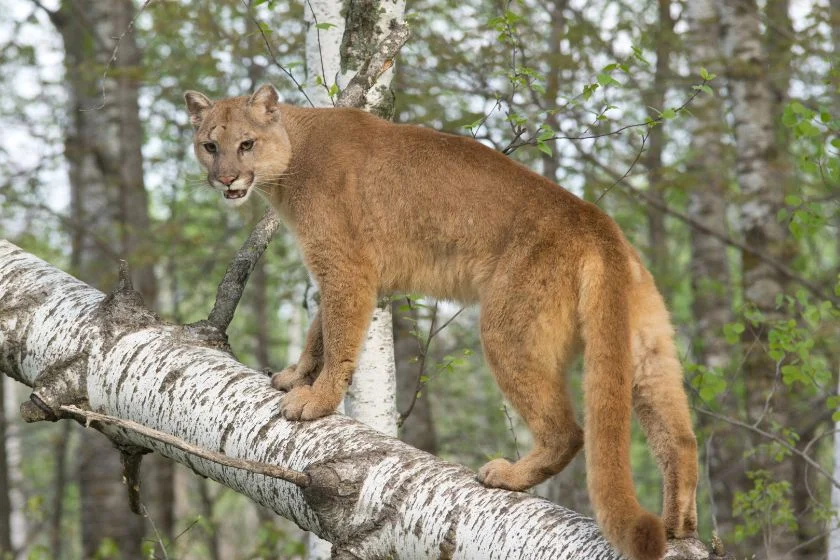
- Scientific Name: Puma concolor
- Classification: Mammal
- Habitat: Steep, rocky canyons, coastal forests, deserts, mountainous terrain
- Diet: Carnivore
- Conservation Status: Least Concern
There are many cougar breeding populations across Idaho, but the good news is that these animals are not human predators.
However, they do not hold our pets in the same regard, attacking them even in their backyards.
Cougars may not primarily prey on humans, but one bold enough to attack a pet at home might also attack its owner in defense.
Such an occurrence could result in injuries or death as a cougar’s 400 PSI bite force can kill a human.
3. Bison
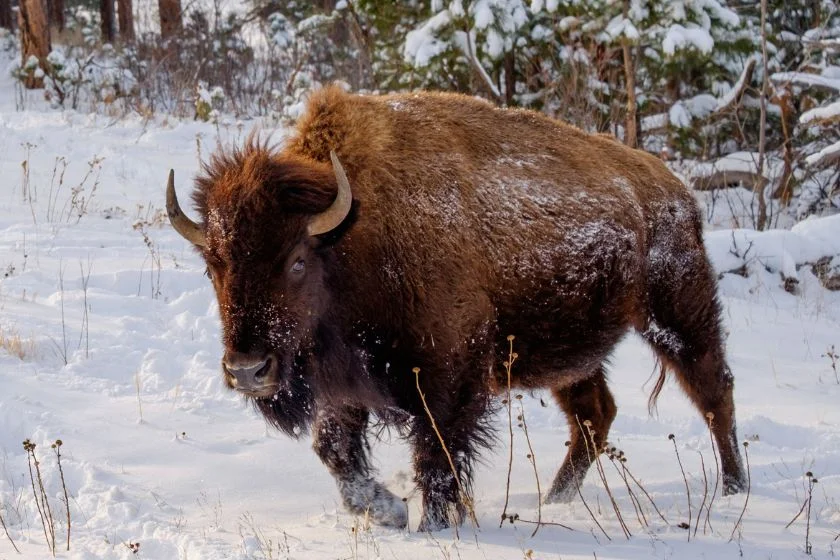
- Scientific Name: Bos bison
- Classification: Mammal
- Habitat: North America’s grasslands and open savannas
- Primary Diet: Herbivore
- Conservation Status: Near Threatened
You may find bison wandering into eastern Idaho from Yellowstone National Park.
They are intimidating and irritable, with brute strength, speed, and rock-solid horns; little wonder they are revered as North America’s largest mammals.
A male bison (bull) can weigh up to 2,000 pounds and reach six feet in height.
Impressively, a bison can outrun a horse for a quarter mile and jump up to six feet vertically.
Bison are deadly threats when provoked; they are confident and would waste no time aggressively reacting when they sense danger around calves, feel harassed, or threatened.
Many human activities seem threatening to bison and could prompt their defensive instincts to charge at a human without warning.
4. Prairie Rattlesnake

- Scientific Name: Crotalus viridis
- Classification: Reptile
- Habitat: Foothills, grasslands, plains, mountains
- Diet: Carnivorous
- Conservation Status: Least Concern
Snakes are common throughout most of Idaho, but the Prairie Rattlesnake is one of the two venomous snakes among the twelve snake species in the state.
You will find the Prairie Rattlesnake mostly in Custer, Lemhi, Valley, and other east-central counties.
This rattlesnake specie is generally not aggressive but will strike when threatened or provoked, such as by unaware hikers.
Prairie Rattlesnake bites are painful and may be lethal to a healthy adult. However, pets may not survive the reptile’s bite.
Victims may have difficulty breathing, impaired vision, or feel nauseated; they may suffer shock, low blood pressure, and internal bleeding in severe cases.
You may argue that rattlesnakes give dry bites, but 75% of their bites are venomous; therefore, you should be careful around the Prairie Rattlesnake.
Like other rattlesnakes, you risk no attack if you steer clear of the Prairie Rattlesnake.
5. Black Widow Spider

- Scientific Name: Latrodectus
- Classification: Arachnid
- Habitat: crevices, hollow logs, loose bark, holes, burrows, small trees, bushes, woodpiles
- Primary Diet: Carnivore
- Conservation Status: No special status
It is no news that the Black Widow is one of Idaho’s most dangerous spiders and, sadly, one of the state’s most common.
You can find it anywhere, even in your yard and home.
While many people are frightened by the spider, the Idaho Department of Fish and Game (IDFG) states that this species is not often aggressive and stings people in an attempt to defend itself.
Its red, hourglass-shaped mark can be pretty attractive, but it is wise to admire it from a distance.
The spider’s bite is often felt like a pin-prick, but the consequences have more negative impacts.
Their venom is neurotoxic, causing chest pain, muscle aches, nausea, muscle tightness, cramping, and a paralysis of the diaphragm, making breathing difficult.
Bites can be fatal but uncommon as only children, the elderly, or the infirm suffer from complications.
6. Hobo Spider
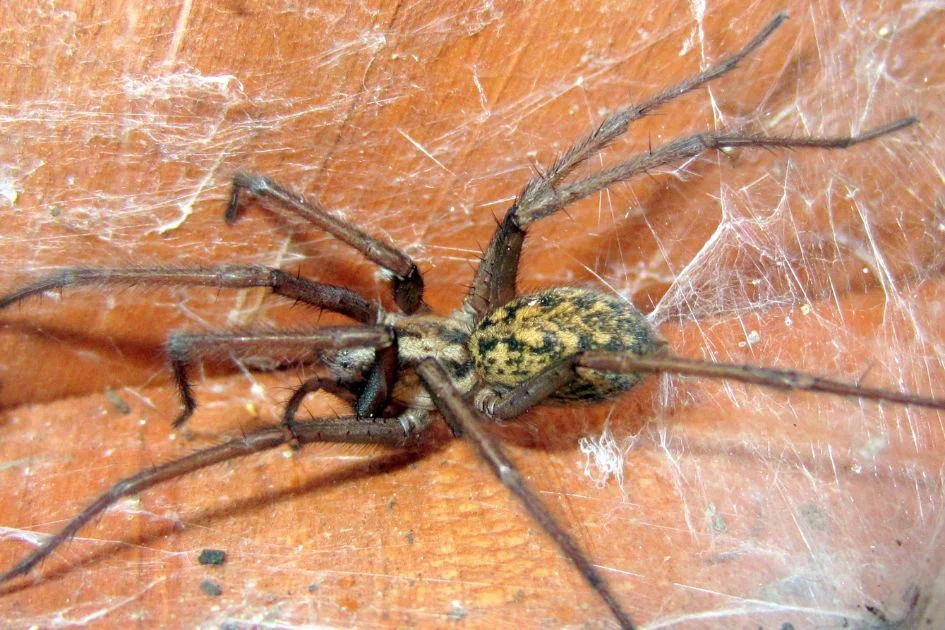
- Scientific Name: Eratigena agrestis
- Classification: Arachnid
- Habitat: Dark, moist areas, holes, cracks
- Primary Diet: Carnivore
- Conservation Status: Not Evaluated
The Hobo Spider is common statewide, from basements to ground-level floors inside homes, especially in Idaho Falls.
It is revered as one of the most feared pests in the state, earning its fearsome reputation for its scary look and venomous bite.
While the spider is not as dangerous as people portray, they are not welcome in homes; in all but its common name, the Hobo Spider is also “the aggressive house spider.”
Hobo Spiders are venomous, and their bite could be painful, causing extreme nausea, headaches, and fatigue.
Fortunately, the spider’s venom is not strong enough to cause life-threatening complications.
7. Yellow Sac Spider
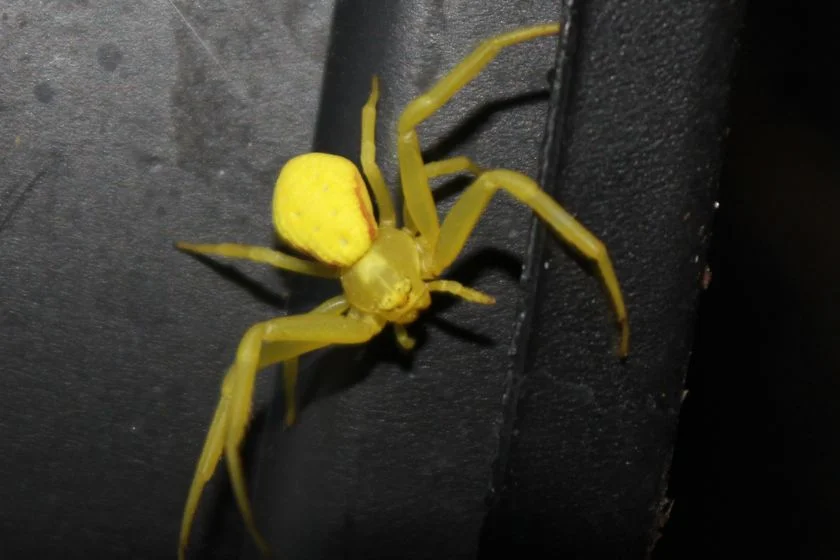
- Scientific Name: Cheiracanthium punctorium
- Classification: Arachnid
- Habitat: Gardens, foliage, wood, and debris
- Diet: Carnivore
- Conservation Status: Not Evaluated
The Yellow Sac is one of the most dangerous Idaho spider species, earning its reputation for a massive yellow sac at the base of its body and a long-lasting, nasty bite.
A dose of venom follows the Yellow Sac Spider’s excruciating bite, causing pain and nausea.
Victims may suffer skin necrosis or anaphylactic shock in extreme cases.
8. Coyotes
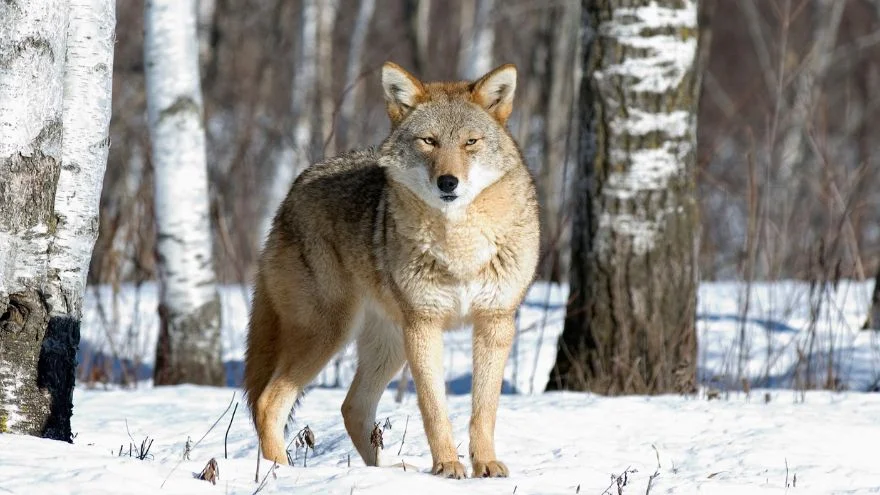
- Scientific Name: Canis latrans
- Classification: Mammal
- Habitat: Oak savannah, woodlands, subalpine forests, temperate rainforests, deserts
- Diet: Carnivores
- Conservation Status: Least Concern
You can find coyotes all year round in most locations in Idaho, with an estimated 52,000-plus living in the state.
Therefore, it is not unusual to run into one, especially during the denning season when you can find them hunting during the day.
While coyotes are ready to back off when they encounter humans, these wild dogs can become aggressive when humans interfere with their young and attack a hindered or injured person.
Reports reveal there were no less than three attacks on pets in Idaho; coyotes attack our pets like cougars.
9. Wolves

- Scientific Name: Canis lupus
- Classification: Mammal
- Habitat: Tundra, woodlands, forests, grasslands, deserts.
- Diet: Carnivore
- Conservation Status: Least Concern
The IDFG estimated the wolf population in Idaho at over 1,500, remaining stable as they counted the exact number in 2019 and 2020.
In June 2022, the state government confirmed 143 sheep deaths as two wolves panicked a flock in the state.
Similarly, a report of a wolf attacking a dog in its home in Shoshone County has appeared on the internet.
Such reports forced the Idaho government to pass a bill on May 5, 2021, allowing the killing of up to 90% of the state’s wolf population.
While you may argue that this is a bad policy or tragedy, the canines have earned a fearsome reputation as one of the state’s most dangerous animals.
Wolves are menacing, measuring over five feet in length and reaching two feet, seven inches in height, with powerful jaws and teeth and powerful bodies.
They travel in packs but tend to fear and avoid humans.
10. Racoons
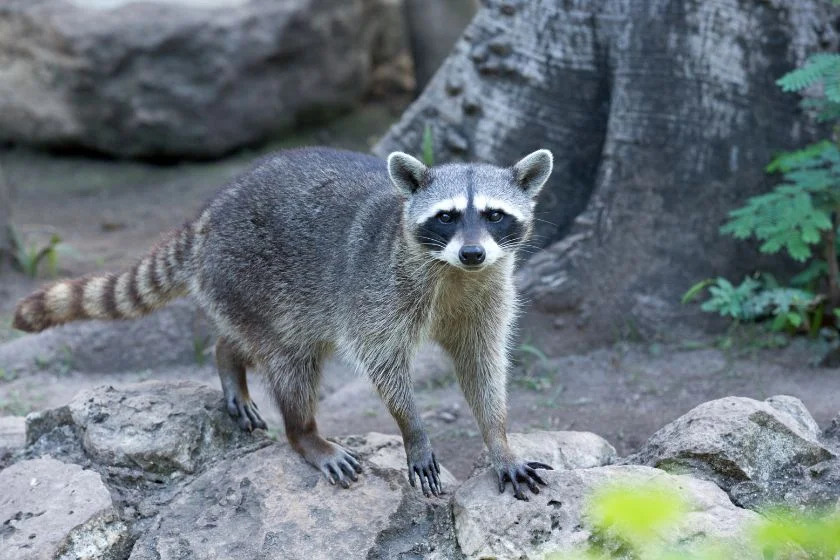
- Scientific Name: Procyon lotor
- Classification: Mammal
- Habitat: Moist woodland areas
- Diet: Omnivore
- Conservation Status: Least Concern
Raccoons are particularly common in towns and cities in southwestern Idaho, especially around Treasure Valley, notoriously looting people’s garbage.
Raccoons often raid bins, animal cages, and pet food bowls to sustain themselves and could get into your house using cat flaps.
It is best if you do not try not to frighten them as they can charge at you, bite, scratch, or hiss if threatened.
Nevertheless, they would not hurt anyone even though they can be curious and come close to you.
Raccoons are guilty of transmitting rabies, Leptospirosis, and raccoon roundworms that can infect people and pets.
They also cause life and property destruction by chewing wirings and damaging walls, ceilings, and woodwork.
11. Moose
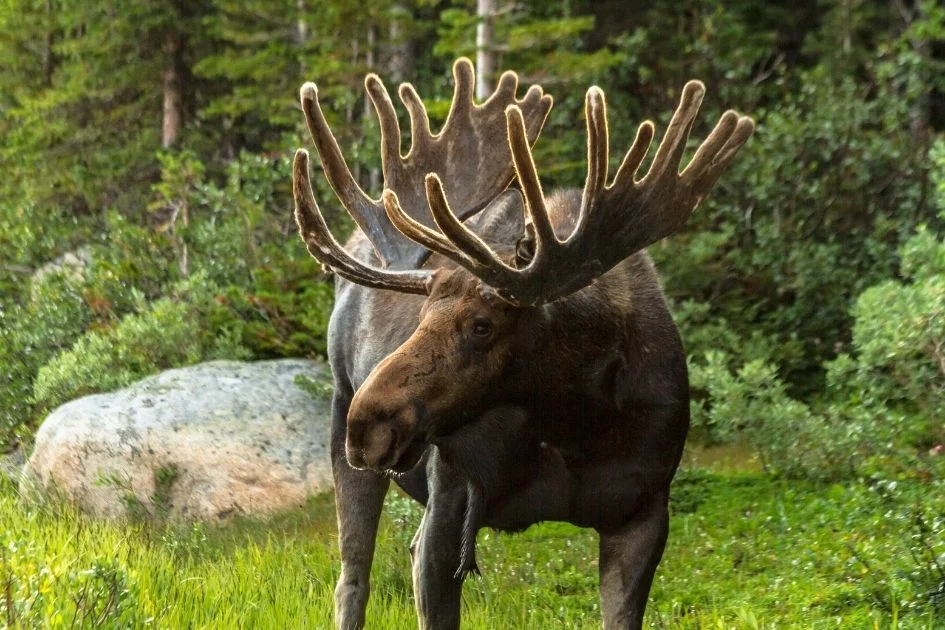
- Scientific Name: Alces alces
- Classification: Mammal
- Habitat: Boreal forests, temperate broadleaf, mixed forests
- Diet: Herbivore
- Conservation Status: Least Concern
Between 10,000 and 12,000 moose live in Idaho. You can find them everywhere, except in the southwestern region and urban Boise.
While they are herbivores and do not prey on humans, these wild deer cousins pose a more significant threat of attacking you within Idaho because of their population size.
They are big, reaching between five and 6.5 feet by shoulder height.
Mature bulls are equipped with wide antlers of over six feet, which they attack with to protect their calves or if they feel threatened.
Reports about moose attacks are rare, but an incident was reported in December 2021.
12. Deer

- Scientific Names: Cervidae
- Classification: Mammal
- Habitat: Rain forests, wetlands, grasslands, deciduous forests, arid shrublands, and mountains.
- Diet: Herbivore
- Conservation Status: Not Extinct
Like all wild animals, deer are potentially dangerous to humans in confinement or when threatened.
In the wild, bucks in rutting seasons engage in fights looking for does to breed with a surging urge to mate and reproduce.
While humans are not the target, getting caught up in a deer fight could lead to puncture wounds, bruising, other forms of injury, or even death from a deer’s deadly antlers.
Does protect their fawns and could charge at you if you get too close.
Sadly, there have also been reports of hunters killed by the same deer they just wounded because injured animals can be very aggressive.
Therefore, it is best to watch them from a distance.
Idaho Wildlife Safety Tips
Visiting Idaho brings you closer to wildlife, interacting with different animals within the state’s forest and potentially dangerous ones within your vicinity.
Applying the following safety tips will protect you and these species.
Never feed wild animals
Feeding wildlife is awful as diseases or parasites could spread at feeding sites. Their nutrition could be affected as well.
For example, a deer could suffer an acid imbalance in its stomach after consuming excessive corn.
Moreover, wild animals, regardless of their size, can inflict harm. Moose that humans feed lose their fear of humans and react aggressively towards them.
Do not go close to young animals that look abandoned
You may find a fawn on your backyard lawn; it would be best if you were not quick to assume it is abandoned.
Its mother could aggressively charge you in your honest attempt to rescue it as mothers are usually protective of their young.
Never allow wildlife to get access to human food or garbage
Raccoons often raid bins, animal cages, and pet food bowls to sustain themselves, spilling a mess that poses health and safety hazards.
Carry and know how to use bear spray
It would be best if you prepare yourself for possible bear attacks as you journey across the woods in Idaho, and using an aerosol bear spray is one of the most effective means.
Barring any other manufacturer’s instruction, point the canister at an aggressive bear and spray the contents for two to three seconds.
Bear sprays effectively deter a charging or aggressive bear from a distance of 1.5 to three meters.
Watch wildlife from a safe distance
It would be wise never to follow or approach wild animals due to their unpredictability and defensive instincts.
Wildlife may quickly feel concerned or threatened and, in their defense, harm people or themselves in an attempt to escape.
Always be aware of your surroundings
While you may be distracted by the beauty of untamed nature, always remember that using all your senses is crucial to your safety.
Refrain from stepping carelessly into overgrown bushes where snakes and other insects may hide.
Also, observe trees, hills, and other elevated areas for bears, wolves, coyotes, and other animals.
Wrap Up
Undoubtedly, Idaho boasts of wildlife’s breathtaking scenery, spanning 20.4 million acres of forest area.
There is so much to see and admire, but ensure never to enjoy watching animals in their natural settings at the expense of your safety and health.






